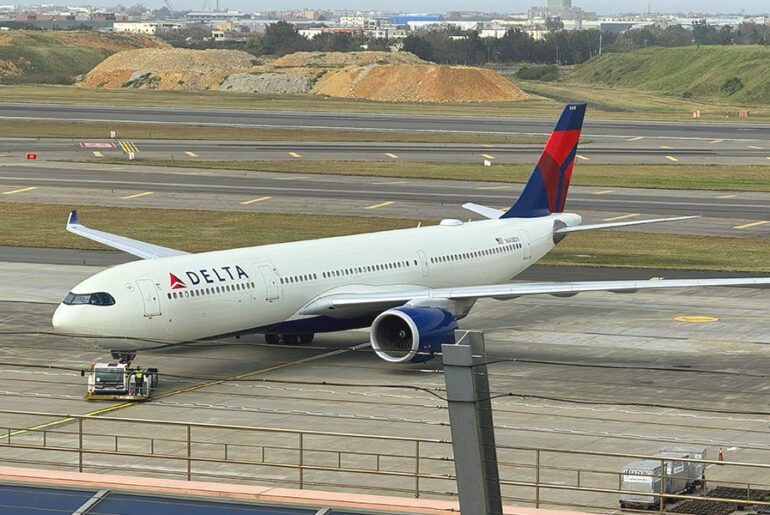A transpacific journey that should have connected Detroit to Tokyo turned into an aviation safety demonstration when Delta flight DL275 experienced a critical engine malfunction. The Airbus A350’s emergency diversion to Los Angeles International Airport showcased both the vulnerabilities of modern aviation technology and the effectiveness of established safety protocols.
What Happened During the Flight
On May 28, 2025, Delta flight DL275 made an unscheduled landing at Los Angeles International Airport following a critical malfunction in the aircraft’s engine anti-ice system during its Pacific Ocean crossing. The aircraft departed from Detroit Metropolitan Wayne County Airport bound for Tokyo Haneda, carrying passengers who expected a routine 13-hour flight across the Pacific.
Roughly five hours into the flight, the pilots detected an engine anti-ice system malfunction involving one of the Rolls-Royce Trent XWB engines powering the Airbus A350. The timing proved crucial, as the aircraft was positioned approximately 620 nautical miles southwest of Anchorage when flight crews made the call to abandon the original flight plan.
Technical Details of the Engine Failure
The malfunction centered on the anti-ice system, a critical component that prevents ice formation on engine components during flight. The anti-ice system was malfunctioning on one of the aircraft’s twin engines, creating a potentially dangerous situation for continued flight over the Pacific Ocean.
Aircraft anti-ice systems serve as the primary defense against ice accumulation, which can severely impact engine performance and aircraft safety. When these systems fail, pilots must evaluate whether continuing the planned route poses acceptable risks to passenger safety.
Flight Timeline and Decision Making
| Time | Event | Location |
| May 27, 15:53 | Departure from Detroit | DTW Airport |
| May 28, ~20:00 | Engine issue detected | 620 miles SW of Anchorage |
| May 28, 01:08 | Emergency landing | LAX Airport |
| Total flight time | Approximately 12 hours | Pacific Ocean route |
The flight landed at 1:08 AM on May 28, 2025, after about 12 hours in the air. The extended flight duration reflected the aircraft’s need to burn fuel before landing and navigate to the safest available airport with appropriate maintenance facilities.
Why LAX Was Selected
The crew’s choice of Los Angeles International Airport demonstrated strategic thinking under pressure. LAX was the safest diversion airport with the right facilities. Several factors influenced this decision:
Operational Advantages:
- Delta’s major hub status at LAX
- Complete maintenance capabilities
- 24-hour operational support
- Passenger rebooking resources
Safety Considerations:
- Weather conditions favorable for landing
- Multiple runway options
- Emergency response capabilities
- Medical facilities availability
The decision avoided potentially riskier alternatives such as smaller Alaskan airports or attempting to reach the original Tokyo destination with a compromised engine system.
Financial and Operational Impact
The incident racked up about $2.3 million in expenses and lost revenue, impacting the aviation industry significantly. The costs encompassed multiple areas:
Cost Breakdown
| Category | Impact | Estimated Cost Range |
| Fuel costs | Wasted fuel + extra consumption | $800,000 – $1,000,000 |
| Passenger accommodation | Hotels, meals, rebooking | $400,000 – $600,000 |
| Aircraft maintenance | Engine repair, inspection | $600,000 – $900,000 |
| Operational disruption | Crew costs, scheduling | $200,000 – $300,000 |
| Total estimated impact | $2.0M – $2.8M |
The financial consequences extended beyond immediate costs. Schedule disruptions affected subsequent flights, while the aircraft remained grounded pending thorough inspection and repair.
Passenger Experience and Response
Most passengers reached Tokyo within a day or two. The airline offered hotels, meals, and new flights. It wasn’t ideal, but it softened the blow of a 12-hour detour. Delta’s response demonstrated established crisis management protocols designed to minimize passenger inconvenience during operational emergencies.
Passengers faced significant disruption to travel plans, with some experiencing delays of 24-48 hours before reaching their final destinations. The airline’s compensation package included:
- Hotel accommodations in Los Angeles
- Meal vouchers during extended layovers
- Priority rebooking on available flights
- Potential monetary compensation under passenger rights regulations
Aviation Safety Implications
The successful handling of flight DL275’s emergency highlighted several critical aspects of modern aviation safety:
Crew Performance
Pilots and dispatch teams act fast when confronted with mechanical failures. The crew’s decision-making process followed established protocols while adapting to specific circumstances.
Technology Limitations
Despite advanced aircraft systems, the incident revealed that even sophisticated anti-ice technology can fail unexpectedly. Advanced predictive analytics could have detected this failure 3-6 hours before takeoff, preventing the diversion entirely.
Industry Learning
The Delta flight DL275 diverted LAX incident has made the aviation company rethink safety and maintenance. Airlines continuously evaluate maintenance schedules and predictive technologies to prevent similar occurrences.
Lessons for Aviation Industry
The DL275 incident reinforced several important principles:
Maintenance Protocols: Enhanced pre-flight inspections of anti-ice systems Regular component replacement schedules Improved diagnostic capabilities
Technology Integration: Better predictive maintenance systems Real-time engine monitoring enhancements Automated failure detection improvements
Emergency Preparedness: Crew training for Pacific Ocean diversions Updated decision-making protocols Enhanced passenger communication systems
Conclusion
Delta flight DL275’s emergency diversion demonstrated both the challenges and strengths of modern commercial aviation. While the Rolls-Royce engine’s anti-ice system failure created a serious safety concern, the crew’s professional response and Delta’s operational capabilities ensured all passengers reached safety without injury.
The $2.3 million financial impact serves as a reminder of aviation’s economic realities, where safety decisions carry significant costs but remain non-negotiable priorities. The incident’s lessons continue influencing industry practices, from maintenance protocols to emergency response procedures.
Most importantly, the successful outcome reinforced passenger confidence that aviation professionals prioritize safety above all other considerations. When faced with potential danger over the Pacific Ocean, the crew chose the conservative path that guaranteed passenger welfare, exemplifying the aviation industry’s fundamental commitment to safety first.


